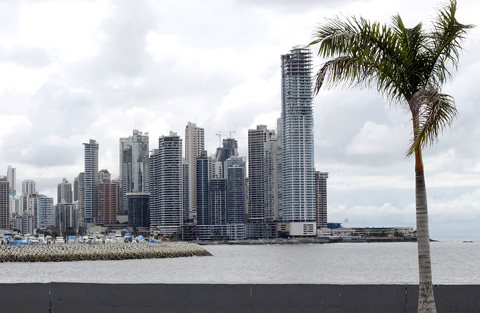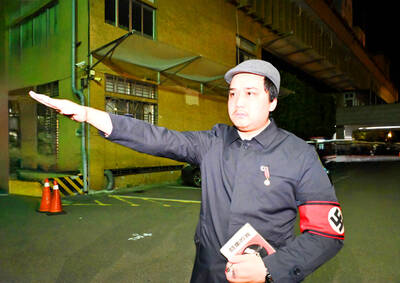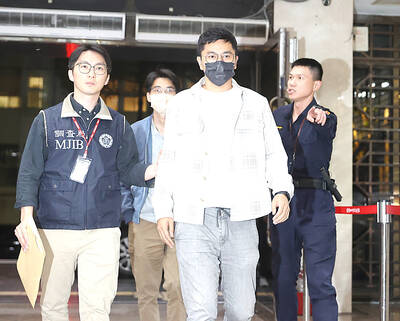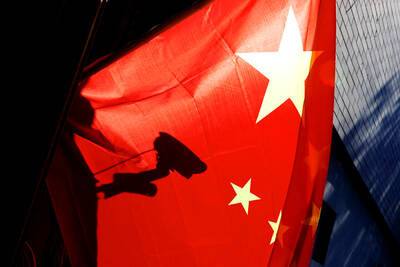A generation after Panama shed a tradition of military rule, canny fiscal management and good stewardship of its emblematic canal have made the tiny country a model of success for today’s frontier markets.
An investor darling that has grown rapidly over the last decade and even managed to dodge recession during the recent global downturn, Panama’s government debt has received a coveted investment grade rating by Fitch and S&P.
Panama will not realize its ambition of joining the world’s most developed nations until it cleans up its murky banking system and narrows a wealth gap that leaves a third of its people in poverty, but economists say it is well-positioned for steady growth.

PHOTO: REUTERS
“What’s striking is that this is such a broad-based economy,” said Boris Segura, an economist with the Royal Bank of Scotland. “Yes, they have the canal, but there is also tourism, construction and a growing financial services sector.”
With a population of just 3.4 million, Panama will never be a China or a Japan, but local leaders say it can aspire to become like Singapore, an affluent and diverse crossroads for international finance and trade.
“Nobody is going to come to Panama to sell to the domestic market. We tell investors ‘Come to Panama and sell to the world,’” Panamian Trade Minister Roberto Henriquez said. He sees the small isthmus nation’s future as a boutique exporter of high-margin goods and services.
Dozens of multinational companies such as Caterpillar, Hewlett Packard and Dell have been drawn to Panama in recent years as the country has thrown its doors open to foreign investment and Panamian President Ricardo Martinelli, in power since July last year, hopes to attract more.
While foreign investors put only about US$500 million a year into Panama in the 1990s, the country attracted US$8.6 billion between 2006 and last year, government and UN data show.
Low taxes, easy immigration and flexible labor laws have been among the attractions, along with an abundance of available land.
“A multinational company takes baby steps and we have room to grow,” said Henry Kardonski, who is directing the conversion of a former US Air Force base into 14km² of mixed-use development near the Panama Canal that will combine light industry and a residential community.
Investors have been impressed with Panama’s tight fiscal balances and pro-business policies, but much of its growth stems from the canal which is a transit point for about 4 percent of global trade.
Storage and distribution centers are expanding along the canal beltway while the transport and finance sectors continue to grow. The government is tapping those industries for tax revenue and drawing from international creditors to expand its infrastructure.
A US$5.25 billion expansion of the canal should be complete in 2014 and the government plans to spend another US$13.6 billion on infrastructure and social programs in the next four years.
“The numbers tell us that we can continue stepping on the pedal without going into profound financial problems in the country,” Henriquez said.
However, with a capital skyline that resembles Dubai of yesteryear and politicians promising to pour even more concrete in a building spree, some fret that spending or growth could spin out of control.
There are also worries Panama has not put to rest the uglier parts of its recent past.
“Are they going to squander these gains? The jury is still out,” said Segura, who is bullish on Panama but uneasy with a recent edict by Martinelli against street protests and his attempts to centralize authority.
It has been more than 20 years since General Manuel Noriega was frog-marched from power after US Marines invaded and extradited the military strongman on drug trafficking charges.
Some worry, though, that Panamanians have uneven memories of the Noriega era and might be too willing to accept another authoritarian figure who promises wealth, stability and more social programs for the poor.
“Back then, there was a lot of money, people say. There was a lot of money in the street,” said vendor Fidelio Chocho, ladling out pineapple juice to customers by the Vatican embassy.
Much has changed in Panama City since that standoff, with luxury condos and a highway overpass now crowding the Vatican Nunciature.
The strong economy reflected in growth figures is also seen on the streets of Panama City, where Noriega’s former officers’ club is being turned into a boutique hotel and the faded colonial quarter is getting a spruce-up.

‘FORM OF PROTEST’: The German Institute Taipei said it was ‘shocked’ to see Nazi symbolism used in connection with political aims as it condemned the incident Sung Chien-liang (宋建樑), who led efforts to recall Democratic Progressive Party (DPP) Legislator Lee Kun-cheng (李坤城), was released on bail of NT$80,000 yesterday amid an outcry over a Nazi armband he wore to questioning the night before. Sung arrived at the New Taipei City District Prosecutors’ Office for questioning in a recall petition forgery case on Tuesday night wearing a red armband bearing a swastika, carrying a copy of Adolf Hitler’s Mein Kampf and giving a Nazi salute. Sung left the building at 1:15am without the armband and apparently covering the book with a coat. This is a serious international scandal and Chinese

PERSONAL DATA: The implicated KMT members allegedly compiled their petitions by copying names from party lists without the consent of the people concerned Judicial authorities searched six locations yesterday and questioned six people, including one elderly Chinese Nationalist Party (KMT) member and five KMT Youth League associates, about alleged signature forgery and fraud relating to their recall efforts against two Democratic Progressive Party (DPP) legislators. After launching a probe into alleged signature forgery and related fraud in the KMT’s recall effort, prosecutors received a number of complaints, including about one petition that had 1,748 signatures of voters whose family members said they had already passed away, and also voters who said they did not approve the use of their name, Taipei Deputy Chief Prosecutor

A US Marine Corps regiment equipped with Naval Strike Missiles (NSM) is set to participate in the upcoming Balikatan 25 exercise in the Luzon Strait, marking the system’s first-ever deployment in the Philippines. US and Philippine officials have separately confirmed that the Navy Marine Expeditionary Ship Interdiction System (NMESIS) — the mobile launch platform for the Naval Strike Missile — would take part in the joint exercise. The missiles are being deployed to “a strategic first island chain chokepoint” in the waters between Taiwan proper and the Philippines, US-based Naval News reported. “The Luzon Strait and Bashi Channel represent a critical access

COUNTERINTELLIGENCE TRAINING: The ministry said 87.5 percent of the apprehended Chinese agents were reported by service members they tried to lure into becoming spies Taiwanese organized crime, illegal money lenders, temples and civic groups are complicit in Beijing’s infiltration of the armed forces, the Ministry of National Defense (MND) said in a report yesterday. Retired service members who had been turned to Beijing’s cause mainly relied on those channels to infiltrate the Taiwanese military, according to the report to be submitted to lawmakers ahead of tomorrow’s hearing on Chinese espionage in the military. Chinese intelligence typically used blackmail, Internet-based communications, bribery or debts to loan sharks to leverage active service personnel to do its bidding, it said. China’s main goals are to collect intelligence, and develop a